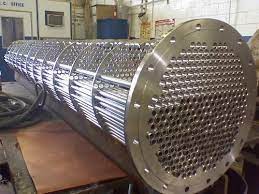Heat exchangers are heat transfer products designed for heat transfer, heat removal, heat rejection, or heat recovery.
- Heat exchangers are used to heating fluids in one of the following ways:
- transferring heat from one fluid stream to another to control temperature (precooling)
- rejecting unwanted heat from a primary to secondary fluid stream (‘process heating’)
- heat recovery from a heat transfer fluid to a heat rejection fluid (‘process cooling’)
All heat exchangers have the following basic components:
a) heat transfer tubes
b) shell
c) tube sheets
d) fin or plate type heat exchanger modules
e) inside and outside headers
f) flow distribution devices
g) trays, saddles, coils gaskets. In addition, heat exchangers can contain flat plates, tubes, or bundles.
Heat Exchangers are designed for many different applications that require the efficient movement of heat from one area to another area in order to lower temperature. The efficiency can be affected by the temperature difference, material selection, and process fluids used. The efficiency of a heat exchanger is determined by the equation:
η = heat recovery/heat to be rejected
Heat exchangers can be designed with heat recovery or heat rejection area, depending on the application. Although heat exchangers have been around for many years, there is still much debate as to their overall efficiency and how to best use them in an industrial process. In mining applications, heat exchangers are used both as heat recovery products and heat rejection products. In heat recovery processes heat exchanger equipment can be used as a preheater/demister, scrubber dryer economizer, cooler, heater unit, and water heater.
There are other areas where they might not be thought of first that can benefit from a heat exchanger such as biofuel production facilities that use glycerin (biofuel) to heat vegetable oil in order to make biodiesel.
There are many different heat exchangers available depending on your needs, such as plate heat exchangers, brazed plate heat exchangers, brazed aluminum heat exchangers, and shell and tube heat exchangers. Each heat exchanger has a different purpose and can be used in several areas of an industry or manufacturing facility. The heat exchanger that we will focus on is the shell and tube, heat exchanger.
The heat transfer fluid flows inside of metal tubes which are heated by another fluid flowing around them such as water flow through the coiled tubing in a solar water heater. In this case for an air conditioner system, the outside coil is filled with heat transfer fluid such as water, which is then cooled by the air conditioner. The heat transfer fluid flows through the tubes inside of the heat exchanger and absorbs heat from the hot heat transfer fluid that has flowed into it through its other set of tube assemblies where another heat source moves that fluid. These areas are separated by a series of finned metal plates to create multiple channels for both fluids to flow through.
The two tubes carrying different fluids are contained within individual chambers, typically made out of aluminum or iron, preventing either one from flowing into each other or mixing together. Inside these chambers are corrugated metal plates attached to long, straight aluminum fins which increase the contact area between the heat transfer fluid and allow more heat exchange between them. The heat transfer fluid with the lower heat capacity flows through the heat exchanger first which creates heat as it passes through.
If you are interested in learning more about heat exchangers, Kinetic Engineering has many resources available, We also have a heat exchanger search page that can help you find what you need for your project!
Kinetic’s heat exchangers are manufactured at our facility located in Piqua, Ohio where we have been since 1969. Throughout our history, we have continued to grow along with the industry by providing quality products to keep up with higher demands. Kinetic Energy is committed to providing heat exchangers for our customers through the design, manufacturing, and shipping processes.


